ET-Updater enhances the Miranda Easytext CG system to provide high-quality broadcast typography for a range of non-Roman scripts. This section describes Easytext’s Unicode typeface handling, and shows how ET-Updater extends this capability.
Easytext and Unicode
Easytext accepts text coded using Unicode UTF-8, which defines up to 65,000 different ‘code points’ (characters) used in scripts throughout the world. This means there is no need to switch between code pages.
Easytext for IS-750, IS-300+ and Intuition works correctly with Unicode, and can handle Arabic, Hebrew and many other international scripts without needing ET-Updater’s script processing.
However, Easytext software for Imagestore IS2 and IS3 has a number of limitations in its Unicode handling, which make it unsuitable for direct use with many scripts.
- Left-to-right rendering only. Easytext will always display the characters it receives in a left-to-right order across the screen. Hebrew and Arabic are written and read from right to left.
- No cursive script joining. Cursive scripts such as Arabic require that certain glyphs have their shape radically altered depending on the context of surrounding letters.
- No ligature support. Some scripts mandate that certain letter combinations are replaced with a single glyph, known as a ligature.
- No character composition. Unicode allows accented characters can be sent as a sequence of base character followed by accent, which are then combined to form a single glyph. Easytext does not support this composition.
Font Support
Easytext uses TrueType fonts, which are available from a number of sources. Some TrueType fonts include a wide range of characters for international scripts. In particular, many comprehensive fonts (such as Arial Unicode and Lucida Sans Unicode) include Presentation Forms and Ligatures as independent glyphs in the font. Presentation Form glyphs are variants of the base glyph, either with modified cursive joining properties, or combined with accents or diacritical marks.
ET-Updater Advanced Script Processing
Using simple control software that sends text to Easytext in its logical order will produce the unwanted effect shown below. Characters are displayed in the incorrect order, and no attempt to join or form ligatures occurs.

Using our advanced script processing algorithms, ET-Updater will convert the logical order to the required visual order, reformat cursive sequences and replace letter combinations with ligatures as required. The finished output is shown below.
![]()
The joining and ligature replacement is table driven, which allows custom ligatures to be defined to take advantage of specific fonts. For example, the common ‘fi’ and ‘fl’ ligatures available in some Latin fonts can be automatically used if required.

This processing is only enabled when the Handles Foreign Scripts option in the Unit properties is disabled.
Limitations
Use of the Advanced Script Processing does impose certain limitations.
- Easytext cannot be allowed to wrap the text automatically – this will cause line breaks to be incorrectly inserted.
- Not all accented characters can be mapped to a ‘combined’ glyph. In some special cases, the accent will not appear directly over the required character.
- Only a single set of processing tables is supported. Problems may occur if a font is specified which does not contain the ligatures and presentation form glyphs specified by the processing tables.
